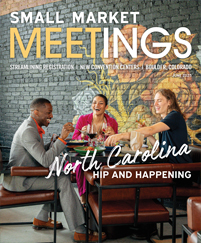Pennsylvania certainly isn’t lacking in history. It was one of the original 13 Colonies, founded in 1682 by William Penn as a refuge for fellow Quakers.
Philadelphia was where the Second Continental Congress was held in 1775, a gathering that produced the Declaration of Independence, which in turn sparked the American Revolution. And after the war, Pennsylvania was the second state to ratify the U.S. Constitution.
Though Philadelphia gets much of history buffs’ attention, planners have their choice of historic venues in smaller cities throughout Pennsylvania.
John Harris-Simon Cameron Mansion
Harrisburg
The John Harris-Simon Cameron Mansion has had many owners — and many expansions — since construction began in 1766. But the home overlooking the Susquehanna River in Harrisburg still has many of its original architectural details.
The mansion even served as the Pennsylvania Female College for a time before being forced to close in 1861, which opened the door for one of the home’s more famous owners: Simon Cameron, a longtime U.S. senator who briefly served as Abraham Lincoln’s secretary of war before being appointed ambassador to Russia. While serving in the post, Cameron traveled all over Europe shopping for furnishings for his new home.
Today, visitors will find giant mirrors from France, hand-carved Italian marble fireplaces and a stained-glass alcove window from Bavaria, all chosen by Cameron himself.
“It’s a very unique space; they don’t make buildings like that anymore,” said Chris Turner, executive director of the Historical Society of Dauphin County, which manages the mansion. And with all the elegant details, “you don’t have to do much decorating.”
The mansion’s entire first floor can accommodate about 150 guests for seated meals, and the parlor, the largest room, can seat about 60 at rounds. The library and office across the hall can be used for additional seating, and the dining room can seat more guests or be used for food service.
The solarium is where planners typically set up the bar, and “that room is beautiful; it’s all windows and Italian marble floors and original wallpaper,” Turner said. The adjoining butler’s walkway also works well for food service, she said. Guests will also have access to upstairs rooms where they can explore the society’s exhibits.












